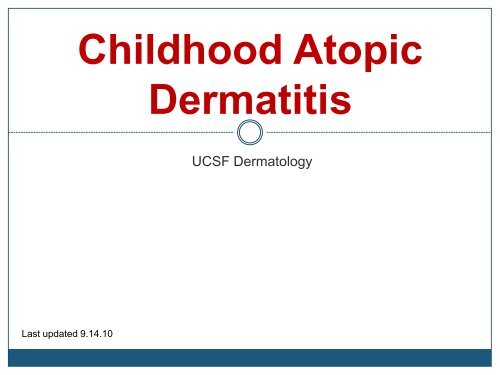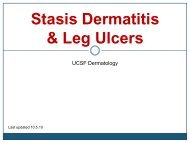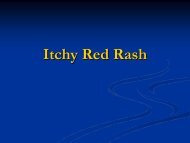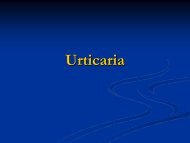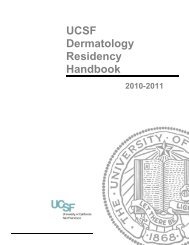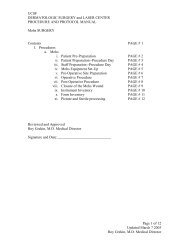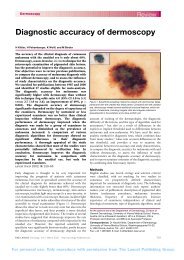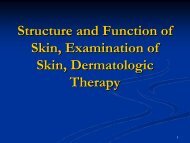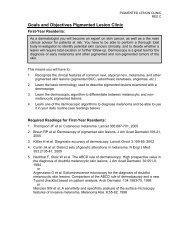Childhood Atopic Dermatitis - Dermatology
Childhood Atopic Dermatitis - Dermatology
Childhood Atopic Dermatitis - Dermatology
Create successful ePaper yourself
Turn your PDF publications into a flip-book with our unique Google optimized e-Paper software.
Last updated 9.14.10<br />
<strong>Childhood</strong> <strong>Atopic</strong><br />
<strong>Dermatitis</strong><br />
UCSF <strong>Dermatology</strong>
Module Instructions<br />
The following module contains a number of<br />
green, underlined terms which are<br />
hyperlinked to the dermatology glossary,<br />
an illustrated interactive guide to clinical<br />
dermatology and dermatopathology.<br />
We encourage the learner to read all the<br />
hyperlinked information.
Goals and Objectives<br />
The purpose of this module is to help medical<br />
students develop a clinical approach to the<br />
evaluation and initial management of patients<br />
presenting with atopic dermatitis.<br />
After completing this module, the medical student<br />
will be able to:<br />
• Identify the morphology of atopic dermatitis in different age<br />
groups<br />
• Differentiate atopic dermatitis from other pruritic skin<br />
disorders<br />
• Name risk factors for developing atopic dermatitis<br />
• Describe an initial treatment plan including patient/parent<br />
education<br />
• Discuss when to refer to a dermatologist
Case One<br />
Carolyn Ku
Case One: History<br />
HPI: Carolyn Ku is a 10 month-old girl who was brought to the<br />
pediatric clinic by her mother for an “itchy red rash” for the last 7<br />
months. The rash waxes and wanes, involving Carolyn‟s face. Her<br />
mother reports Carolyn is bathed daily using a “normal” soap.<br />
Sometimes they use moisturizing lotion if her skin appears dry.<br />
They recently introduced peas into her diet and wonder whether this<br />
may be contributing to the rash.<br />
PMH: Normal birth history. She is healthy aside from an episode of<br />
wheezing at 5 months of age. No hospitalizations or surgeries. Her<br />
immunizations are up to date.<br />
Medications: None<br />
Allergies: None<br />
Family history: Mother has asthma and allergic rhinitis<br />
Social history: Lives in a house with her parents, no pets or recent<br />
travel<br />
ROS: “itches all night”
Case One: Skin Exam<br />
How would you describe her skin exam?
Case One: Skin Exam<br />
Erythematous illdefined<br />
plaques with<br />
overlying scale and<br />
crust on her cheeks
Case One, Question 1<br />
What elements in the history are important<br />
to ask in this case<br />
a. Which moisturizers are used and where?<br />
b. Does she scratch or rub her skin?<br />
c. Does the rash keep her awake at night?<br />
d. All of the above
Case One, Question 1<br />
Answer: d<br />
What elements in the history are important to<br />
ask in this case<br />
a. Which moisturizers are used and where? (Provides<br />
information about distribution. Also, the moisturizer<br />
may be exacerbating the problem)<br />
b. Does she scratch or rub her skin? (Provides<br />
information about associated pruritus, which will<br />
impact treatment)<br />
c. Does the rash keep her awake at night? (Provides<br />
information about severity, which will impact<br />
treatment)<br />
d. All of the above
Case One, Question 2<br />
What is the most likely diagnosis given the<br />
history and physical exam findings?<br />
a. Seborrheic dermatitis<br />
b. <strong>Atopic</strong> dermatitis<br />
c. Neonatal lupus<br />
d. Scabies<br />
e. Contact dermatitis
Case One, Question 2<br />
Answer: b<br />
What is the most likely diagnosis given the<br />
history and physical exam findings?<br />
a. Seborrheic dermatitis (would expect erythematous<br />
patches and plaques with greasy, yellowish scale)<br />
b. <strong>Atopic</strong> dermatitis<br />
c. Psoriasis (presents as erythematous plaques with<br />
overlying scale)<br />
d. Scabies (intensely pruritic papules, often with<br />
excoriation, burrows may be present)<br />
e. Contact dermatitis (would expect history of contact<br />
with allergen and erythema with superimposed<br />
vesicles or bullae)
Case One, Question 3<br />
Which of the following statements supports<br />
the diagnosis of atopic dermatitis:<br />
a. Chronic nature of the rash<br />
b. Distribution of the rash<br />
c. Symptom of pruritus<br />
d. Family history of atopic disease<br />
e. All of the above
Case One, Question 3<br />
Answer: e<br />
Which of the following statements supports<br />
the diagnosis of atopic dermatitis:<br />
a. Chronic nature of the rash (present x 7 months)<br />
b. Distribution of the rash (predominantly on the<br />
cheeks)<br />
c. Symptom of pruritus (itching)<br />
d. Family history of atopic disease<br />
e. All of the above
<strong>Atopic</strong> <strong>Dermatitis</strong>: The Basics<br />
<strong>Atopic</strong> dermatitis (AD) is a chronic, pruritic, inflammatory<br />
skin disease with a wide range of severity<br />
AD is one of the most common skin disorders in developed<br />
countries, affecting up to 20% of children & 1-3 % of adults<br />
• In most patients, AD develops before the age of 5 and typically<br />
clears by adolescence<br />
Primary symptom is pruritus (itch)<br />
• AD is often called “the itch that rashes”<br />
• Scratching to relieve AD-associated itch gives rise to the „itchscratch‟<br />
cycle and can exacerbate the disease<br />
Patients experience periods of remission and exacerbation
AD: Clinical Findings<br />
Lesions typically begin as erythematous papules, which<br />
then coalesce to form erythematous plaques that may<br />
display weeping, crusting, or scale<br />
Distribution of involvement varies by age:<br />
• Infants and toddlers: eczematous plaques appear on the<br />
cheeks forehead, scalp and extensor surfaces<br />
• Older children and adolescents: lichenified, eczematous<br />
plaques in flexural areas of the neck, elbows, wrists, and<br />
ankles<br />
• Adults: lichenification in flexural regions and involvement of<br />
the hands, wrists, ankles, feet, and face (particularly the<br />
forehead and around the eyes)<br />
Xerosis is a common characteristic of all stages
Case One, Question 4<br />
What percentage of children with atopic<br />
dermatitis also have or will develop asthma or<br />
allergic rhinitis?<br />
a. 0-15%<br />
b. 15-30%<br />
c. 30-50%<br />
d. 50-80%<br />
e. 80-100%
Answer: d<br />
Case One, Question 4<br />
What percentage of<br />
children with atopic<br />
dermatitis also have or<br />
will develop asthma or<br />
allergic rhinitis?<br />
50-80% of children will<br />
have another atopic<br />
disease<br />
The <strong>Atopic</strong> Triad<br />
<strong>Atopic</strong><br />
dermatitis<br />
Asthma<br />
Allergic<br />
rhinitis
Typical AD for Infants and Toddlers<br />
Affects the cheeks, forehead, scalp, and extensor surfaces<br />
Erythematous, illdefined<br />
plaques on<br />
the cheeks with<br />
overlying scale and<br />
crusting.<br />
Erythematous, illdefined<br />
plaques on<br />
the lateral lower leg<br />
with overlying scale
More Examples of <strong>Atopic</strong> <strong>Dermatitis</strong><br />
Note the distribution of face<br />
and extensor surfaces
Typical AD for Older Children<br />
Affects flexural areas of neck, elbows, knees, wrists, and ankles<br />
Lichenified,<br />
erythematous<br />
plaques behind the<br />
knees<br />
Erythematous,<br />
excoriated papules<br />
with overlying crust<br />
in the antecubital<br />
fossa
<strong>Atopic</strong> <strong>Dermatitis</strong> ≠ Eczema<br />
Eczema is a nonspecific term that<br />
refers to a group of inflammatory skin<br />
conditions characterized by pruritus,<br />
erythema, and scale.<br />
• <strong>Atopic</strong> dermatitis is a specific type<br />
of eczematous dermatitis.
<strong>Atopic</strong> <strong>Dermatitis</strong>: Pathogenesis<br />
The cause of AD is multifactorial and not<br />
completely understood.<br />
The following factors are thought to play<br />
varying roles:<br />
• Genetics<br />
• Skin Barrier Dysfunction<br />
• Impaired Immune Response<br />
• Environment
Back to Case One<br />
Carolyn Ku
Case One, Question 5<br />
Which of the following recommendations<br />
would you provide to Carolyn‟s parents?<br />
a. Mild soap, as little as needed to remove dirt<br />
b. Daily or twice daily application of moisturizing<br />
ointment or cream<br />
c. Hydrocortisone 2.5% ointment to the face twice<br />
daily<br />
d. Hydroxyzine 1 tsp (1mg/kg) PO at bedtime<br />
e. All of the above
Case One, Question 5<br />
Answer: e<br />
Which of the following recommendations would you<br />
provide to Carolyn‟s parents?<br />
a. Mild soap, as little as needed to remove dirt<br />
b. Daily or twice daily application of moisturizing ointment or<br />
cream<br />
c. Hydrocortisone 2.5% ointment to the face twice daily<br />
d. Hydroxyzine 1 tsp (1mg/kg) PO at bedtime<br />
e. All of the above<br />
Carolyn is having an exacerbation of her AD and<br />
needs both gentle skin care and treatment of the<br />
inflammation in her skin
<strong>Atopic</strong> <strong>Dermatitis</strong>: Treatment<br />
Combination of short-term treatment to manage flares<br />
and longer-term strategies to help control symptoms<br />
between flares<br />
Recommend gentle skin care<br />
• Tepid baths without washcloths or brushes<br />
• Mild soaps<br />
• Pat dry<br />
• Emollients: petrolatum and moisturizers<br />
• Use ointments or thick creams (no watery lotions)<br />
• Apply once to twice daily to whole body (within 3 minutes of<br />
bathing for optimal occlusion)<br />
Identification and avoidance of triggers and irritants<br />
(such as wool and acrylic fabrics)
AD: Treatment Continued<br />
Treat acute inflammation with topical corticosteroids<br />
• Ointments are preferred over creams<br />
• Low potency is usually effective for the face<br />
• Body and extremities often require medium potency<br />
• Using stronger steroid for short periods and milder steroid for<br />
maintenance helps reduce risk of steroid atrophy and other side<br />
effects<br />
• Potential local side effects associated with topical corticosteroid<br />
therapy use include striae, telangiectasias, atrophy, and acne<br />
Topical calcineurin inhibitors: 2nd-line therapy<br />
• Use when the continued use of topical steroids is ineffective or<br />
when the use of topical steroids is inadvisable
<strong>Atopic</strong> <strong>Dermatitis</strong>: Treatment<br />
Treat pruritus with antihistamines<br />
• Antihistamines help to break the itch/scratch cycle<br />
• Standing night-time 1 st generation H1 antihistamines (i.e.<br />
hydroxyzine) are helpful<br />
Treat co-existing skin infection with systemic<br />
antibiotics<br />
Patients should be referred to a dermatologist<br />
when:<br />
• Patients have recurrent skin infections<br />
• Patients have extensive and/or severe disease<br />
• Symptoms are poorly controlled with topical steroids
Case One, Question 5<br />
What is the most likely corticosteroid you<br />
would choose for Carolyn‟s facial lesions?<br />
a. clobetasol ointment<br />
b. fluocinonide ointment<br />
c. triamcinolone ointment<br />
d. hydrocortisone ointment<br />
e. hydrocortisone cream
Case One, Question 5<br />
Answer: d<br />
What is the most likely corticosteroid you<br />
would choose for Carolyn‟s facial lesions?<br />
a. clobetasol ointment<br />
b. fluocinonide ointment<br />
c. triamcinolone ointment<br />
d. hydrocortisone<br />
ointment<br />
e. hydrocortisone cream
Topical Steroid Strength<br />
Class 1 Superpotent Clobetasol 0.05%<br />
Class 2 High Potency Fluocinonide 0.05%<br />
Class 3 High/Medium Potency Triamcinolone ointment 0.1%<br />
Class 4 Medium Triamcinolone cream 0.1%<br />
Class 5 Medium/Low Triamcinolone lotion 0.1%<br />
Class 6 Low Potency Fluocinolone 0.01%<br />
Desonide 0.05%<br />
Class 7 Low Potency Hydrocortisone 1%<br />
Note: Clobetasol 0.05% is STRONGER than hydrocortisone 1%.<br />
Remember to look at the class not the percentage
Prescribing Topical Steroids<br />
The following slides will review how to<br />
estimate the amount of medication to<br />
prescribe according to the affected<br />
body surface area (BSA)
Estimating BSA via Palm of Hand<br />
1 Palm = 1%<br />
BSA
Estimating topicals: Fingertip unit<br />
Quantity of topical<br />
medication placed on<br />
pad of finger from distal<br />
tip to DIP joint<br />
Fingertip unit = 500 mg<br />
= treats 2% BSA
Estimating Topical Therapy Amounts<br />
2% BSA = 500mg = 0.5g<br />
2% BSA bid x 1 month = 0.5 g x 2 x 30 = 30 g<br />
5% BSA bid x 1 month = 1.25 g x 2 x 30 = 75 g<br />
Can also use the “Rule of 15”<br />
%BSA x 15 = grams needed to treat bid x 1 month<br />
10% BSA bid x 1 month = 150 g<br />
100% BSA bid x 1 month = 1500 g
Case One, Question 6<br />
Which of the following prescriptions should be<br />
used to treat Carolyn‟s AD for a 3 month duration?<br />
a. Hydrocortisone 2.5% ointment, apply to affected area<br />
BID, dispense 90 grams<br />
b. Hydrocortisone 2.5% cream, apply to affected area<br />
BID, dispense 30 grams<br />
c. Hydrocortisone 2.5% ointment, apply to affected area<br />
BID, dispense 30 grams<br />
d. Hydrocortisone 2.5% cream, apply to affected area<br />
BID, dispense 90 grams
Case One, Question 6<br />
Answer: a<br />
Which of the following prescriptions should be<br />
used to treat Carolyn‟s AD for a 3 month duration?<br />
a. Hydrocortisone 2.5% ointment, apply to affected area<br />
BID, dispense 90 grams (2% BSA x 15 = 30 grams for 1<br />
month x3 = 90 grams)<br />
b. Hydrocortisone 2.5% cream, apply to affected area BID,<br />
dispense 30 grams<br />
c. Hydrocortisone 2.5% ointment, apply to affected area BID,<br />
dispense 30 grams<br />
d. Hydrocortisone 2.5% cream, apply to affected area BID,<br />
dispense 90 grams
Avoiding steroid atrophy<br />
Guide to max strengths for maintenance based on<br />
location:<br />
• Eyelids, face: Class 6 (e.g., desonide)<br />
• Flexures, butt, groin: Class 5 (e.g.,triamcinolone lotion)<br />
• Arms, Legs, Back: Class 4 (e.g., triamcinolone<br />
cream)<br />
Give short bursts of more potent steroids for flares<br />
Parent education and written instruction are key to<br />
success
Case One, Question 7<br />
Carolyn‟s parents would also like more information<br />
regarding the association between food allergies and<br />
atopic dermatitis. What can you tell them?<br />
a. There is no correlation between AD and food allergies<br />
b. Food allergy is a more likely trigger if the onset or<br />
worsening of the AD correlates with exposure to the<br />
food<br />
c. A positive allergen test proves that the allergy is<br />
clinically relevant<br />
d. Elimination of food allergens in patients with AD and<br />
confirmed food allergy will not lead to clinical<br />
improvement
Case One, Question 7<br />
Answer: b<br />
Carolyn‟s parents would also like more information<br />
regarding the association between food allergies<br />
and atopic dermatitis. What can you tell them?<br />
a. There is no correlation between AD and food allergies (not true)<br />
b. Food allergy is a more likely trigger if the onset or worsening of<br />
the AD correlates with exposure to the food<br />
c. A positive allergen test proves that the allergy is clinically relevant<br />
(not true)<br />
d. Elimination of food allergens in patients with AD and confirmed food<br />
allergy will not lead to clinical improvement (not true. If the food<br />
allergy is clinically relevant, then the elimination of the food allergen<br />
will lead to improvement)
Allergens and <strong>Atopic</strong> <strong>Dermatitis</strong><br />
The role of allergy in AD remains controversial<br />
Many patients with AD have sensitization to food and<br />
environmental allergens<br />
• However, evidence of allergen sensitization is not proof of a clinically<br />
relevant allergy<br />
Food allergy as a cause of, or exacerbating factor for, AD is<br />
uncommon.<br />
• Identification of true food allergies should be reserved for refractory AD<br />
in children in whom the suspicion for a food allergy is high<br />
• Infants with AD and food allergy may have additional findings that<br />
suggest the presence of food allergy, such as vomiting, diarrhea, and<br />
failure to thrive<br />
Elimination of food allergens in patients with AD and confirmed<br />
food allergy can lead to clinical improvement
Case Two<br />
Joanna Shafer
Case Two: History<br />
HPI: Joanna Shafer is a 10 year-old girl with a history of<br />
atopic dermatitis, normally well-controlled with emollients<br />
and occasional topical steroids who was brought in by her<br />
mother with an itchy red rash on the back of her thighs.<br />
PMH: atopic dermatitis<br />
Medications: hydrocortisone 2.5% ointment<br />
Allergies: none<br />
Family history: little sister with atopic dermatitis<br />
Social history: lives in a house with parents and sister.<br />
Attends 4 th grade, favorite subject in school is spelling.<br />
ROS: no fevers
Case Two: Skin Exam<br />
Multiple<br />
erythematous<br />
papules and plaques<br />
with erosions
Case Two, Question 1<br />
What is your next step in the evaluation of<br />
Joanna‟s skin condition?<br />
a. Obtain a skin bacterial culture<br />
b. Skin biopsy<br />
c. Apply a potent topical corticosteroid<br />
d. Start topical antibiotics<br />
e. None of the above
Case Two, Question 1<br />
Answer: a<br />
What is your next step in the evaluation of<br />
Joanna‟s skin condition?<br />
a. Obtain a skin bacterial culture<br />
b. Skin biopsy (not necessary for diagnosis)<br />
c. Apply a potent topical corticosteroid (will not help<br />
with evaluation)<br />
d. Start topical antibiotics (a large majority of patients<br />
with AD are colonized with S. aureus, treating<br />
locally with topical antibiotics is usually not<br />
effective)<br />
e. None of the above
Case Two: Evaluation<br />
Skin bacterial culture should be considered during<br />
hyperacute, weepy flares of AD and when<br />
pustules or extensive yellow crust are present<br />
Patients with AD are susceptible to a variety of<br />
secondary cutaneous infections such as<br />
Staphylococcus aureus and Group A<br />
Streptococcal infections<br />
These infections are a common cause of AD<br />
exacerbations<br />
Systemic antibiotics should be used to treat these<br />
infections
Another Example of S. aureus Skin Infection<br />
This patient has<br />
excoriated papules on<br />
the chin as well as<br />
erythematous plaques<br />
around the eyes<br />
bilaterally with<br />
overlying yellow<br />
crusting (impetigo)
Case Three<br />
Mark Maldonado
Case Three: History<br />
HPI: Mark is a 9 year-old boy who was brought in<br />
by his father who is concerned about the “white<br />
spots” on Mark‟s face<br />
PMH: mild asthma, no history of hospitalizations<br />
Medications: albuterol when needed<br />
Allergies: none<br />
Family history: mother had a history of childhood<br />
atopic dermatitis<br />
Social history: lives at home with his mother and<br />
father<br />
ROS: negative
Case Three, Question 1<br />
How would you describe Mark‟s skin exam?
Case Three: Skin Exam<br />
Poorly defined<br />
hypopigmented, scaly<br />
patches on the face
Case Three, Question 2<br />
What is the most likely diagnosis?<br />
a. pityriasis alba<br />
b. vitiligo<br />
c. tinea versicolor<br />
d. seborrheic dermatitis
Case Three, Question 2<br />
Answer: a<br />
What is the most likely diagnosis?<br />
a. pityriasis alba<br />
b. vitiligo (typical lesion is a sharply demarcated,<br />
depigmented, round or oval macule or patch)<br />
c. tinea versicolor (generally does not affect the<br />
face)<br />
d. seborrheic dermatitis (would expect<br />
erythematous patches and plaques with greasy,<br />
yellowish scale)
Diagnosis: Pityriasis Alba<br />
Pityriasis alba is a mild, often asymptomatic,<br />
form of AD of the face<br />
Presents as poorly marginated,<br />
hypopigmented, slightly scaly patches on the<br />
cheeks<br />
Typically found in young children (with darker<br />
skin), often presenting in spring and summer<br />
when the normal skin begins to tan
Pityriasis Alba: Treatment<br />
Reassure patients and parents that it generally<br />
fades with time<br />
Use of sunscreens will minimize tanning,<br />
thereby limiting the contrast between diseased<br />
and normal skin<br />
If moisturization and sunscreen do not improve<br />
the skin lesions, consider low strength topical<br />
steroids
Take Home Points<br />
AD is a chronic, pruritic, inflammatory skin disease with a wide<br />
range of severity<br />
AD is one of the most common skin disorders in developed<br />
countries, affecting ~ 20% of children and 1-3% of adults<br />
Distribution and morphology of skin lesions varies by age<br />
A large percentage of children with AD will develop asthma or<br />
allergic rhinitis<br />
The pathogenesis of AD is multifactorial; genetics, skin barrier<br />
dysfunction, impaired immune response, and the environment<br />
play a role<br />
Treatment for AD includes long-term use of emollients and gentle<br />
skin care as well as short-term treatment for acute flares
Take Home Points<br />
Acute inflammation is treated with topical steroids<br />
Treat pruritus with antihistamines<br />
Secondary skin infections should be treated with systemic<br />
antibiotics<br />
Identification of true food allergies should be reserved for<br />
refractory AD in children in whom the suspicion for a food<br />
allergy is high<br />
Pityriasis alba is a mild form of AD of the face in children<br />
Sunscreen and emollients are the 1 st -line treatments for<br />
patients with pityriasis alba<br />
Reassure patients and parents that pityriasis alba will fade<br />
with time
End of the Module<br />
Abramovits W. <strong>Atopic</strong> dermatitis. Section C: Overview of inflammatory skin diseases<br />
– the latest findings in cellular biology. J Am Acad Dermatol 2005;53:S86-93.<br />
Berger Timothy G, "Chapter 6. Dermatologic Disorders" (Chapter). McPhee SJ,<br />
Papadakis MA, Tierney LM, Jr.: CURRENT Medical Diagnosis & Treatment 2010:<br />
http://www.accessmedicine.com/content.aspx?aID=747.<br />
<strong>Dermatology</strong> glossary. June 2007.<br />
http://missinglink.ucsf.edu/lm/<strong>Dermatology</strong>Glossary/index.html<br />
James WD, Berger TG, Elston DM, “Chapter 5. <strong>Atopic</strong> <strong>Dermatitis</strong>, Eczema, and<br />
Noninfectious Immunodeficiency Disorders” (chapter). Andrews‟ Diseases of the<br />
Skin Clinical <strong>Dermatology</strong>. 10 th ed. Philadelphia, Pa: Saunders Elsevier; 2006: 69-<br />
76.<br />
Simpson EL. <strong>Atopic</strong> dermatitis: a review of topical treatment options. Curr Med Res<br />
Opin 2010;26:633-40.<br />
Spergel JM. Role of allergy in atopic dermatitis (eczema). Uptodate.com. 5/2010.<br />
Suh KY. Food Allergy and <strong>Atopic</strong> <strong>Dermatitis</strong>: Separating Fact from Fiction. Semin<br />
Cutan Med Surg. 2010;29:72-78.


